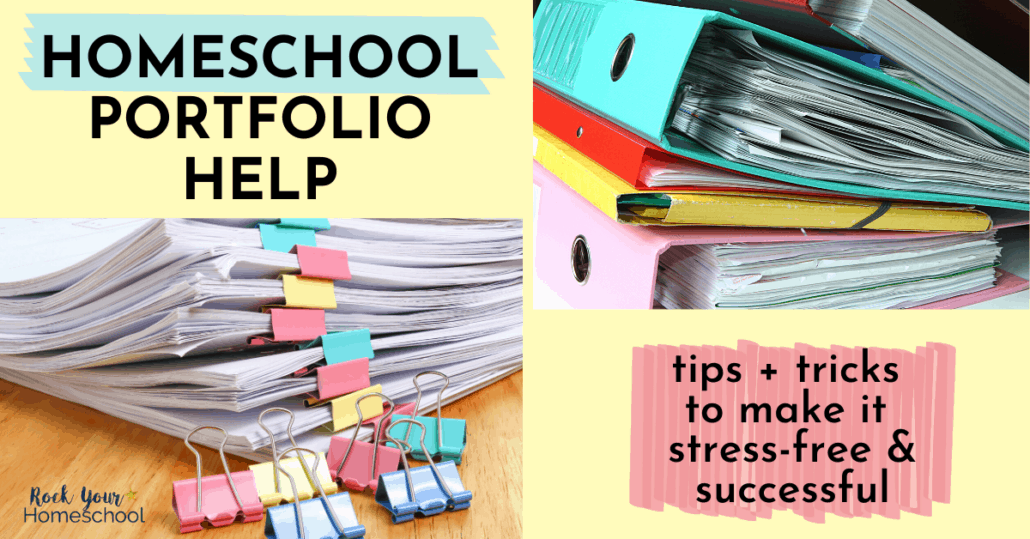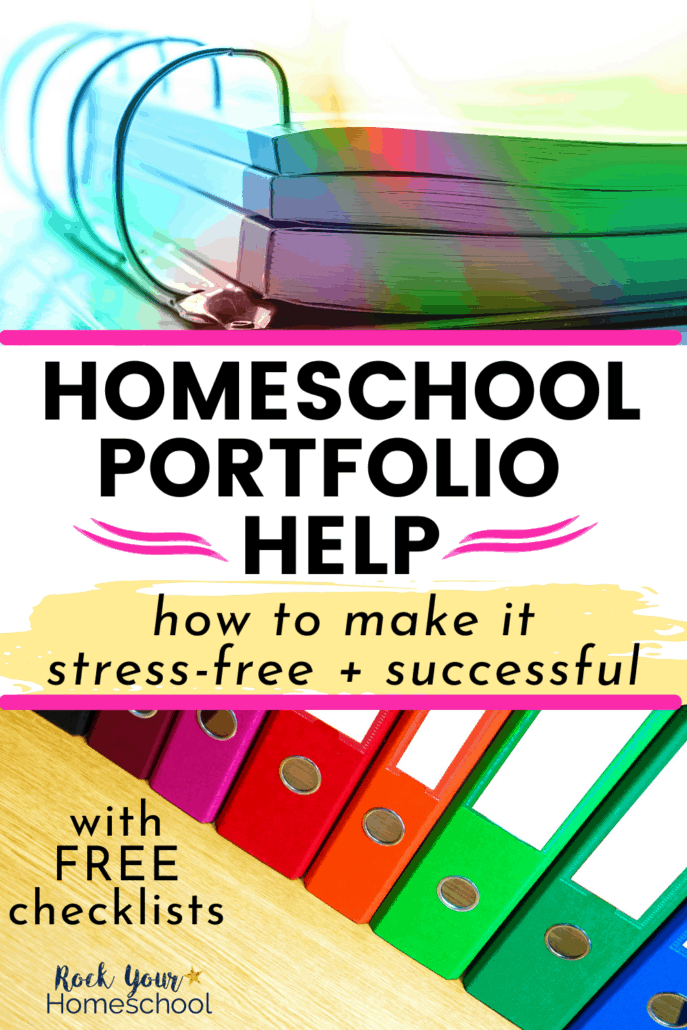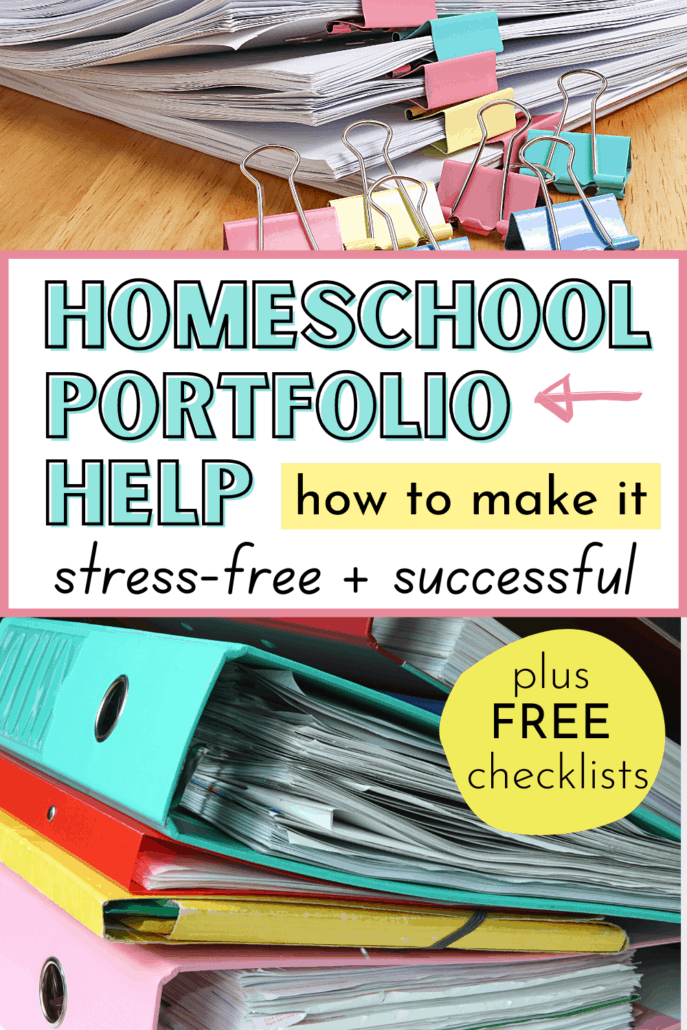Homeschool Portfolio Help: How to Make It Stress-Free & Successful
This post may contain affiliate links. Please read my disclosure statement. Thanks for visiting!
Need some homeschool portfolio help? No worries!
This part of your homeschool experience doesn't have to be stressful. In fact, you can use this time for some special benefits - and even make it fun 😊
Check out these ideas, tips, and tricks for putting together a homeschool portfolio that you can feel good about.
Oh, and get your FREE homeschool portfolio checklists HERE!

Why You Might Need Some Homeschool Portfolio Help
Nothing trips up new homeschoolers like putting together a homeschool portfolio. Parents stress out and overthink what needs to be included, making the process even harder for them.
This will be the eighth year that I put together a homeschool portfolio. And let me tell you that it gets easier every year. Even in a strict homeschool state like Pennsylvania!
It doesn't need to be an intimidating process that makes you break out in a sweat.
It’s all about showing your homeschool evaluator how your child has progressed throughout your school year. (Or just selecting which pieces of homeschool work you'd like to save for personal record-keeping).
If the process makes your hands feel clammy, here's everything you need to know to put together the best homeschooling portfolio possible. I sure could have used some homeschool portfolio help like this when we were getting started!
What is a Homeschool Portfolio?
A homeschool portfolio is an option for assessments at the end of the school year that showcases your child’s educational process throughout the school year.
The goal of a homeschool portfolio is to show what your child has learned and accomplished, as well as showing their progress and what your family uses to teach your child.
Every homeschool has a different approach.
Some families consider their portfolios similar to a scrapbook, showing all of their children's progress throughout the year. It helps preserve memories and shows your children how far they have come each year.
Others prefer to use this method because standardizing testing is either not for their child or something they feel is fundamentally inappropriate for evaluating kids. **If the homeschool laws in your state require standardized testing, you MUST follow those guidelines.
When you make a portfolio, remember that you know your child better than anyone, including whoever is evaluating this portfolio. That's why I love these unique homeschool portfolio ideas!
As the homeschool parent, you have the skills and knowledge necessary to show whoever reviews the portfolio that you've put together your child's unique strengths, weaknesses, and learning ability.

Do I Need to Have a Homeschool Portfolio?
As a homeschool parent, you must know your state's laws to determine whether or not you're required to have a homeschool portfolio (and possibly portfolio evaluation).
Laws vary from state to state, and some states offer options.
A common option is for parents to either use standardized testing yearly or have a portfolio reviewed by a certified teacher.
HSLDA is a great place to start for finding your homeschool state laws. Also, I encourage you to do a search for "your state" + homeschool laws. For example, I use Ask Pauline for amazing information on homeschooling in Pennsylvania.
The Different Types of Homeschool Portfolios
If you decide that you want to use homeschool portfolios for assessments, you have to decide what it will look like.
The most common option is a three-ring binder with subject dividers to help keep everything organized.
Still, as technology grows, more parents opt for digital portfolios and albums where they upload their child's work online for the teacher to assess.
Here are a few options that you might consider when making a portfolio:
1. Three Ring Binders
A common way to store a homeschool portfolio is to use three-ring binders to organize work samples.
It makes it easy to store work by subject or dates. And clear page protectors can be used to store all of the papers.
You also can use photo album pages to keep photographs of projects, artwork, and field trips.
2. Electronic Portfolios
We live in a digital world, so it’s no wonder that more and more parents are selecting to use electronic portfolios.
All you need is a scanner (or app) and camera (or smartphone).
Then, you can upload examples of work into albums online or flashdrives. This option is great if you have limited storage space, and it makes sharing photos of field trips and projects easy.
3. Accordion File
If you don’t want to hole-punch work, accordion files are a popular option that lets you file papers with ease.
You can label each of the pockets by date or subject and file them away throughout the year.
4. Portable Boxes
Another option is to have portable boxes, such as shoebox-style containers or bins, where you keep examples of your child’s work.
You might include different works of art, examples from each subject, and photos from trips.

Myths About Homeschool Portfolios
Before we talk about what you need to include in a portfolio, I want to debunk a few myths that parents often think are true when we talk about making homeschool portfolios.
1. You Need to Include Everything You Did All Year
The assessor you work with would prefer if you didn't show everything you did all year. Can you imagine how long that assessment would take?
The goal is to show progress, and you can show progress without detailing every little thing that you did. Show your child’s favorite works or those that demonstrate how far they have progressed throughout the year.
It’s okay to show a table of contents that lists all of the topics you might have covered in science or history, but I assure you that whoever looks at your portfolio doesn’t need a step-by-step for every day that your family had school 😉
2. You Have to Show Mastery
Learning is spiral, and many subjects take a year or two (or more) to master.
Don’t worry about showing that your child fully mastered the American Revolution or such. They’ll learn about it again when they’re older.
Kids continue to learn and practice their multiplication skills for years. If your child doesn't have it fully mastered, that's okay - as long as they progress at a pace that works for them and shows improvement.
3. It Should Be Perfect
No homeschool portfolio can or will be "perfect" because there are so many ways that you can demonstrate your child's progression throughout the school year.
It's okay if you forget something. Many assessors ask questions, which helps them truly understand what happened throughout the school year.
What Should I Include in a Homeschool Portfolio?
It's normal to stress over what to include in a homeschool portfolio.
Remember, the goal is to showcase educational progress.
Requirements differ from state to state, so what you include may be different. Be sure to read your state's laws to make sure you don't miss anything vital.
Some examples of what you might keep in a portfolio include:
- Learning objectives or summaries for each subject
- Monthly logs of activities
- A list of books read together
- A list of educational videos that your family watched together.
- Photographs from field trips
- Lesson samples from all of the major subjects to show progress
- Writing samples
- Games you use to support learning
- Monthly schedule
- Extracurricular activities
- Artwork that your child created
- Fitness logs

Homeschool Portfolio Help: Tips & Tricks
When I put together my first homeschool portfolio, I found it helpful to read what other parents did and what they included in their portfolio.
So, naturally, I wanted to share what I do each year for all of my boys.
Throughout the school year, I *try* to pick out pieces from each subject that show what we worked on together and their progress.
I say *try* because I'm not always the best at doing this activity throughout the year. The boys and I get busy with our homeschool fun and soccer stuff. Usually, I use bins or boxes to store work so I can go back and sort when it comes time for homeschool portfolio prep.
When sorting my boys' work, I include a minimum of three pieces of work from writing and math. I pick something from the beginning, middle, and end of the school year.
This type of selection shows where the child started at the start of the year and where they ended. It's a fine way to show their progress!
I include what curricula or subjects we covered throughout the year. Also, I show a few worksheets or projects for science and history.
I also include photographs of the large projects we complete throughout the year, along with any field trips that tie into these subjects.
Our homeschool portfolio also includes a list of all the books that the child read individually and together as a family.
If standardized test scores are required for that grade level, I include those results.
Don’t overthink it! Making a homeschool portfolio doesn’t have to be complex.
**The best advice that I've received from homeschool friends and our evaluator is to keep it as simple as possible. Do NOT go overboard! We're in this homeschool thing together - so follow your homeschool state laws and keep it at that.
If You Need to Meet with a Homeschool Evaluator...
Once you have everything together, it's time to meet with your evaluator upon your scheduled date and time.
My boys and I are so blessed to be able to use the same homeschool evaluator each year because she's able to evaluate K-12 (an important consideration, if you're thinking about homeschooling through high school).
Oh, and it’s totally okay to discuss your child’s strengths and weaknesses. It shows that, as a homeschool parent, that you understand your kids and their whole picture.
All you need to do is sit back, relax, and talk about the year you had with your kids 😊
5 Tips for Creating the Best Homeschool Portfolio for Your Family
If you feel a bit nervous about putting together your homeschool portfolio, here are five useful tips that should help you:
1. Don’t Be Nervous
The first year that I put together homeschool portfolios, I felt sick to my stomach.
What if I don’t show my child’s progress well? What if I forget to include something that my child needs to know? Will the teacher fail my portfolio, ending our homeschooling journey?
All of these types of questions were swirling around my head. And for no reason! The whole homeschool evaluation process was easy peasy.
Take a breath! Most states just want to see that your child has made adequate progress based on their age and ability.
If you teach your child regularly and progress through the curriculum you purchased or put together yourself, your child has made progress.
2. Keep Your Homeschool Year Organized
At the start of the year, you know that you need to put together a portfolio by the end of the school year, so don't do what I did one year and put together a portfolio the week of the scheduled appointment.
Yes, I did that one year, and I nearly had a panic attack.
Stay organized and use a few of your homeschool planning days, preferably at the end of the month, to pull together all of the works you want to include.
If you went on a field trip or made an awesome solar system project, take pictures and favorite them on your phone. Jot down the books you read together and grab your favorite piece of writing.
3. Show Improvements Throughout the School Year
Your goal is to show how your child learns and progresses throughout the school year. The best way to do that is to showcase their improvements.
Writing and math are the two easiest subjects to show improvements. It's easy to see how a child's writing skills progressively get better.
As a parent, it's easy to see how our kids grow and change throughout the school year, but the portfolio's goal is to show a stranger how your child has grown and changed.
4. Don’t Forget Outside Lessons
Art lessons, dance classes, gymnastics, school lessons, and whatever else your child loves should be included in your portfolio. That also means you should include online classes that your child takes!
One of your goals is to provide a well-rounded education for your kids. When your child takes piano lessons, they're learning music and enjoying an extracurricular activity.
Gymnastics, dance, soccer, and other sports count towards homeschool physical education.
5. Include Pictures of Field Trips, Sports, Projects, and More!
Field trips and more count as education as well.
If you visit a farm and see how it works, kids learn! Going to the museum or local art museum are educational trips.
You can include pictures or a list of field trips and sports to count towards physical education and social skills. A homeschool evaluator enjoys seeing how your kids receive what they need to grow and thrive in all areas of their lives, including soccer and basketball!
Final Thoughts for Your Homeschool Portfolio Help
The goal of a homeschooling portfolio is to show that your child has made improvement and progress throughout the year.
Your homeschool portfolio doesn't have to be perfect or color-coded. It only needs to meet your state's requirements and show the evaluator what they need to know.
Plus, you'll have an amazing way to highlight and look back upon all the wonderful work and learning your child has made this year 🎉
I truly hope that you've found the homeschool portfolio help that you need. If you have any questions, please leave them in the comment area below!
And make sure to get your FREE homeschool portfolio checklists HERE!
